The Desalination Economic Evaluation Program DEEP is software, available for free download, developed by the International Atomic Energy Agency (IAEA). This tool can be used for performance and cost evaluation of various power and seawater desalination co-generation configurations. The latest version DEEP 5.1 which was released in late 2014, adds new features that enhance the financial economic analysis of nuclear desalination plants and already been supported by a new modern user friendly interface.
The highlights of DEEP 5.1 are:
-
Overall visual improvement for easier navigation between the input, analysis and the results
-
Detailed cash flow analysis of dual purpose desalination plant, showing a detailed overview of the project financing. This analysis is appropriate for use in 'bankable' feasibility studies
-
Scenario manager screen, for comparing scenarios and importing/exporting to files.
-
All features introduced in previous versions, such as sensitivity analysis and case comparison have been reworked and optimized for faster and easier access. The default parameters have been also updated to reflect generic cases according to latest developments.
DEEP is suitable for comparison analysis among different plant types (steam, gas, combined cycle and heat only plants), different fuels (nuclear, oil, coal) and various desalination options including Multi-Effect Distillation (MED), Multi-Stage Flash (MSF), Reverse Osmosis (RO) and hybrid options. It includes formulation of different alternatives such as different turbines configurations, backup heat, intermediate loop, water transport costs and carbon tax.







